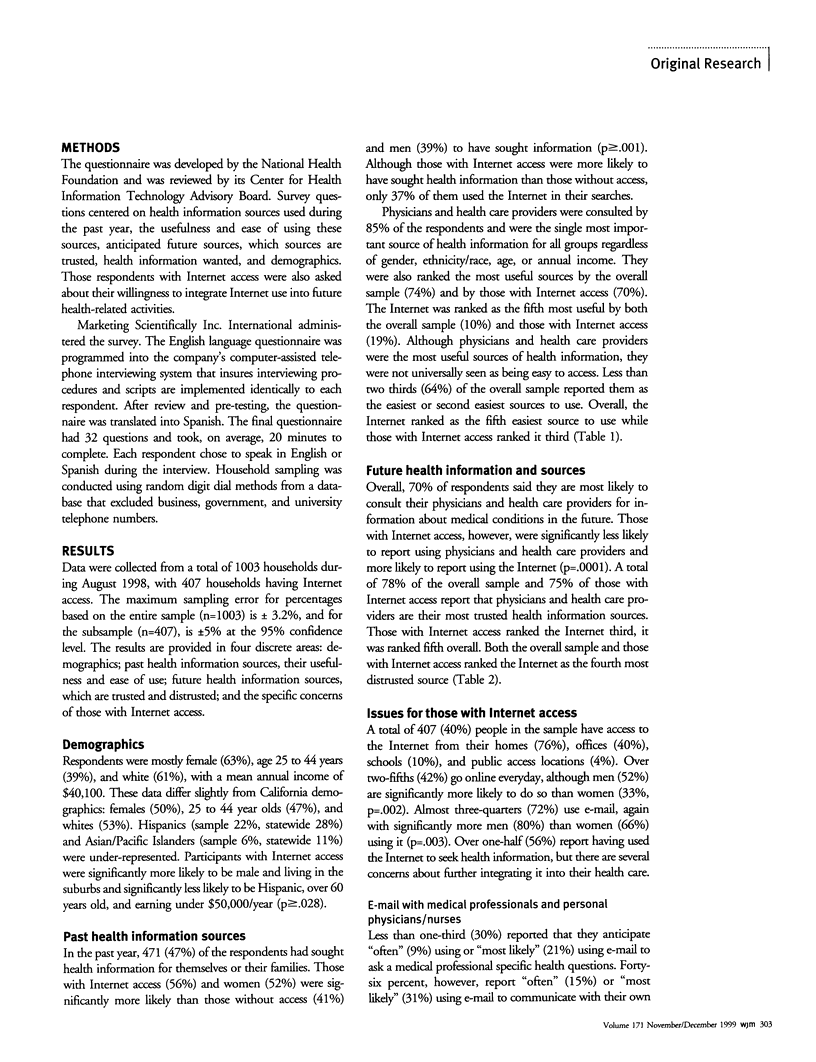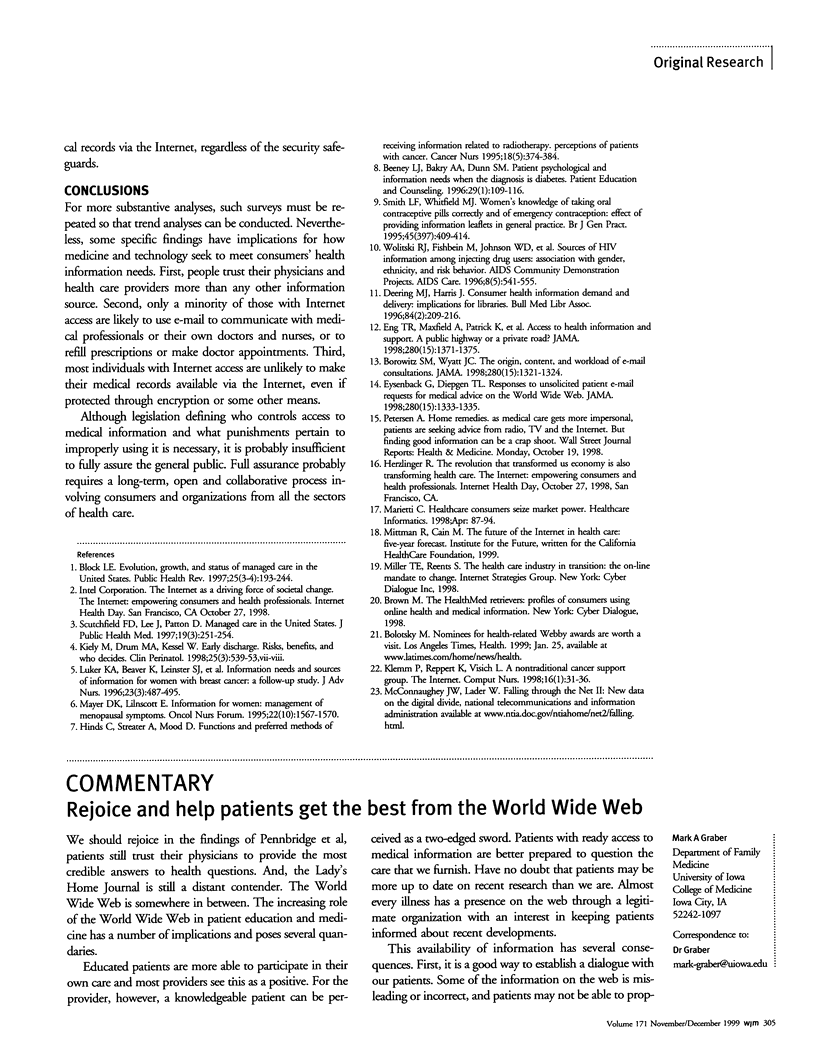Abstract
OBJECTIVE: To understand how Californians use and rate various health information sources, including the Internet. RESEARCH DESIGN: Computer-assisted telephone interviews through which surveys were conducted in English or Spanish. SUBJECTS: A household sample generated by random digit dialing. The sample included 1007 adults (18+), 407 (40%) of whom had access to the Internet. MAIN OUTCOME MEASURES: Past health information sources used, their usefulness and ease of use; future health information sources, which are trusted and distrusted; and concerns about integrating the Internet into future health information seeking and health care behaviors. RESULTS: Physicians and health care providers are more trusted for information than any other source, including the Internet. Among those with Internet access, a minority use it to obtain health information, and a minority is "very likely" to use e-mail to communicate with medical professionals or their own doctors and nurses, to refill prescriptions, or to make doctor appointments. Also, most of those with Internet access are "unlikely" to make their medical records available via the Internet, even if securely protected. CONCLUSIONS: The public, including frequent Internet users, has major concerns about the confidentiality of electronic medical records. Legislation may not assuage these fears and a long-term, open and collaborative process involving consumers and organizations from all the health care sectors may be needed for full public assurance.
Full text
PDF



Selected References
These references are in PubMed. This may not be the complete list of references from this article.
- Beeney L. J., Bakry A. A., Dunn S. M. Patient psychological and information needs when the diagnosis is diabetes. Patient Educ Couns. 1996 Oct;29(1):109–116. doi: 10.1016/0738-3991(96)00939-1. [DOI] [PubMed] [Google Scholar]
- Block L. E. Evolution, growth, and status of managed care in the United States. Public Health Rev. 1997;25(3-4):193–244. [PubMed] [Google Scholar]
- Borowitz S. M., Wyatt J. C. The origin, content, and workload of e-mail consultations. JAMA. 1998 Oct 21;280(15):1321–1324. doi: 10.1001/jama.280.15.1321. [DOI] [PubMed] [Google Scholar]
- Deering M. J., Harris J. Consumer health information demand and delivery: implications for libraries. Bull Med Libr Assoc. 1996 Apr;84(2):209–216. [PMC free article] [PubMed] [Google Scholar]
- Eng T. R., Maxfield A., Patrick K., Deering M. J., Ratzan S. C., Gustafson D. H. Access to health information and support: a public highway or a private road? JAMA. 1998 Oct 21;280(15):1371–1375. doi: 10.1001/jama.280.15.1371. [DOI] [PubMed] [Google Scholar]
- Eysenbach G., Diepgen T. L. Responses to unsolicited patient e-mail requests for medical advice on the World Wide Web. JAMA. 1998 Oct 21;280(15):1333–1335. doi: 10.1001/jama.280.15.1333. [DOI] [PubMed] [Google Scholar]
- Hinds C., Streater A., Mood D. Functions and preferred methods of receiving information related to radiotherapy. Perceptions of patients with cancer. Cancer Nurs. 1995 Oct;18(5):374–384. [PubMed] [Google Scholar]
- Kiely M., Drum M. A., Kessel W. Early discharge. Risks, benefits, and who decides. Clin Perinatol. 1998 Sep;25(3):539-53, vii-viii. [PubMed] [Google Scholar]
- Klemm P., Reppert K., Visich L. A nontraditional cancer support group. The Internet. Comput Nurs. 1998 Jan-Feb;16(1):31–36. [PubMed] [Google Scholar]
- Luker K. A., Beaver K., Leinster S. J., Owens R. G. Information needs and sources of information for women with breast cancer: a follow-up study. J Adv Nurs. 1996 Mar;23(3):487–495. doi: 10.1111/j.1365-2648.1996.tb00010.x. [DOI] [PubMed] [Google Scholar]
- Marietti C. Healthcare consumers seize market power. Healthc Inform. 1998 Apr;15(4):87-8, 90-2, 94. [PubMed] [Google Scholar]
- Mayer D. K., Linscott E. Information for women: management of menopausal symptoms. Oncol Nurs Forum. 1995 Nov-Dec;22(10):1567–1570. [PubMed] [Google Scholar]
- Scutchfield F. D., Lee J., Patton D. Managed care in the United States. J Public Health Med. 1997 Sep;19(3):251–254. doi: 10.1093/oxfordjournals.pubmed.a024626. [DOI] [PubMed] [Google Scholar]
- Smith L. F., Whitfield M. J. Women's knowledge of taking oral contraceptive pills correctly and of emergency contraception: effect of providing information leaflets in general practice. Br J Gen Pract. 1995 Aug;45(397):409–414. [PMC free article] [PubMed] [Google Scholar]
- Wolitski R. J., Fishbein M., Johnson W. D., Schnell D. J., Esacove A. Sources of HIV information among injecting drug users: association with gender, ethnicity, and risk behaviour. AIDS Community Demonstration Projects. AIDS Care. 1996 Oct;8(5):541–555. doi: 10.1080/09540129650125506. [DOI] [PubMed] [Google Scholar]


